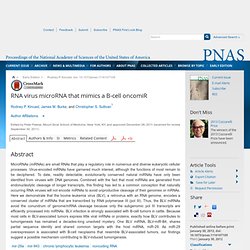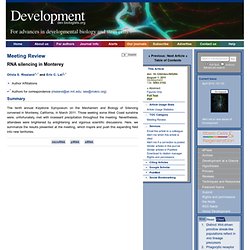

Henry Furneaux Ph.D.: Telomerase RNA biogenesis... Henry Furneaux Ph.D.: A Role for Small RNAs in D... A Role for Small RNAs in DNA Double-Strand Break Repair. To view the full text, please login as a subscribed user or purchase a subscription.

Click here to view the full text on ScienceDirect. Figure 1 DCLs Are Required for Efficient DSB Repair in Arabidopsis (A) Schematic representation of DSB repair in the DGU.US reporter system. The DGU.US reporter (R) line harbors an I-SceI site located within the direct repeats (U) of a nonfunctional GUS. (B and C) Representative GUS staining images for DSB repair analysis in the T, R, and RxT plants and RxT plants in the indicated mutant backgrounds (−/−) or their corresponding wild-type (+/+) backgrounds. (D) The relative repair rate in the indicated plants determined by GUS staining. (E) Detection of repaired DNA in the indicated plants by PCR using primers p1 and p2 depicted in (A), Histone H4 was also amplified and used as the internal control. Figure 2 DSB Induces the Production of diRNAs Specifically Around the DSB Site in Arabidopsis Figure 3 A Role for diRNAs in DSB Repair in Arabidopsis Figure 4.
Twitter. Plant biology: PNAS 'Tomato immune recept... Plant biology: Development 'Somatic small... Henry Furneaux Ph.D.: Mutually Exclusive Binding... Henry Furneaux Ph.D.: Why does siRNA persist ? A... Plant biology: Plant Cell 'A new tool for... FurnoX: New sequencer should work... Oxford Nanopore megaton announcement: “Why do you need a machine?” – exclusive interview for this blog!
Sometimes this genome blogging lark really pays off. Yesterday was one of those days as I got a sneak preview of the big announcement at AGBT, and 20 minutes to speak with Oxford Nanopore’s Dan Turner (Director of Applications), Clive Brown (Chief Technical Officer) and Zoe McDougall (Director of Comms). The downside of course was that I couldn’t tell anyone what they said until the embargo was lifted at 5pm today!
I asked as many questions as I could without knowing the contents of the AGBT talk. I probably should have asked a bunch more. I do remember saying “wow” quite a lot. First, go and read the press release! Executive Summary The MinIon Firstly you need to know this is pronounced “min, ion” rather than “min-yon”. “Hungry Hippo” sequencing The sample lives in solution and the DNA floats around, there is no attachment to beads or solid surfaces. Fast-Slow Sequencing Nanopore can ratchet down the speed of the DNA passing through the pore. Read lengths Accuracy. Plant biology: PNAS 'Homology-independent...
Nicholas Mark Murphy: HPV16 E6 RNA Interference... Henry Furneaux Ph.D.: RNA virus microRNA that mi... RNA virus microRNA that mimics a B-cell oncomiR. Author Affiliations Edited by Peter Palese, Mount Sinai School of Medicine, New York, NY, and approved December 28, 2011 (received for review September 30, 2011) Abstract MicroRNAs (miRNAs) are small RNAs that play a regulatory role in numerous and diverse eukaryotic cellular processes.

Virus-encoded miRNAs have garnered much interest, although the functions of most remain to be deciphered. To date, readily detectable, evolutionarily conserved natural miRNAs have only been identified from viruses with DNA genomes. Footnotes. MicrobeWorld: RNA virus encodes microRNA... Henry Furneaux Ph.D.: Myeloid cell expression of... Plant biology: Free in PNAS 'A long nonco... Plant biology: Free in PNAS 'Plant second... Henry Furneaux Ph.D.: Genome-wide Identification... Plant biology: Plant J 'SoMART, a web ser... Plant biology: RT @theplantjournal: SoMAR... FurnoX: Ferric, not ferrous, heme... Henry Furneaux Ph.D.: RNA Dynamics in Aging Bact...
RNA Dynamics in Aging Bacterial Spores. To view the full text, please login as a subscribed user or purchase a subscription. Click here to view the full text on ScienceDirect. Figure 1 rRNA Dynamics in Aging Spores (A–C) RNA was extracted from decoated B. subtilis (PY79) spores at the indicated age and temperature and analyzed in a microfluidic gel (see Experimental Procedures). Arrows designate the positions of 23S rRNA (upper) and 16S rRNA (lower). (D) qRT-PCR analysis was performed on cDNA derived from aging B. subtilis (PY79) spores incubated at the indicated temperatures (see Experimental Procedures).
(E) Bioanalyzer pseudogel of RNA extracted from decoated spores and vegetative cells of the WT strain (PY79) (see Experimental Procedures). See also Figure S1. Figure 2 Depletion of RNaseY Reduces Degradation of Spore RNA (B and C) qRT-PCR analysis of select transcripts in aging WT (PY79) spores (green) versus RNaseY-depleted spores (ES83: Pxylose-rny-cm) (purple) (see Experimental Procedures). See also Figure S2 and Table S1. ? Henry Furneaux Ph.D.: Sequencing of rifampicin-r... Henry Furneaux Ph.D.: Environmentally regulated... Henry Furneaux Ph.D.: Environmentally regulated... Henry Furneaux Ph.D.: Essential Features and Rat... Plant biology: Plant Journal 'MIGS: MiRNA... MIGS: MiRNA Induced Gene Silencing - de Felippes - The Plant Journal.
Cell at CellPress: How does RNA Polymerase po... Plant biology: Trends in Plant Science 'L... Henry Furneaux Ph.D.: RNA: A new layer of regula... Henry Furneaux Ph.D.: Cisplatin targets DNA or R... Cancer drug cisplatin found to bind like glue in cellular RNA. An anti-cancer drug used extensively in chemotherapy binds pervasively to RNA -- up to 20-fold more than it does to DNA, a surprise finding that suggests new targeting approaches might be useful, according to University of Oregon researchers.

Medical researchers have long known that cisplatin, a platinum compound used to fight tumors in nearly 70 percent of all human cancers, attaches to DNA. Its attachment to RNA had been assumed to be a fleeting thing, says UO chemist Victoria J. DeRose, who decided to take a closer look due to recent discoveries of critical RNA-based cell processes. "We're looking at RNA as a new drug target," she said. "We think this is an important discovery because we know that RNA is very different in tumors than it is in regular healthy cells. The National Institutes of Health- and UO-funded research is detailed in a paper placed online ahead of regular publication in ACS Chemical Biology, a journal of the American Chemical Society. Robert West: Non-coding RNAs in human d... Non-coding RNAs in human disease : Abstract : Nature Reviews Genetics. Henry Furneaux Ph.D.: H. Gobind Khorana, 1968 No...
H. Gobind Khorana, 1968 Nobel Winner for RNA Research, Dies. His death was announced by the Massachusetts Institute of Technology, where Dr. Khorana was a professor emeritus. Dr. Khorana, who received his early schooling from his village teacher under a tree, advanced his education through scholarships and fellowships to become an authority on the chemical synthesis of proteins and nucleic acids, the large molecules in cells that carry genetic information.
He received the 1968 Nobel Prize in Physiology or Medicine with Robert W. Holley of Cornell University and Marshall W. Their experiments looked at the nucleic acids found in RNA, a chemical in cells that translates the genetic information contained in DNA. NYTimes Science: H. Gobind Khorana, 1968 No... Henry Furneaux Ph.D.: Cell - ncRNA- and Pc2 Meth... Henry Furneaux Ph.D.: A One-Step Miniprep for Pl... Henry Furneaux Ph.D.: Helicobacter pylori suppr... Henry Furneaux Ph.D.: RNAi promotes heterochroma... Henry Furneaux Ph.D.: The RNA-binding protein Hu... Henry Furneaux Ph.D.: A Long Noncoding RNA Contr... Henry Furneaux Ph.D.: Genomic Maps of Long Nonco... Plant biology: PLoS ONE 'AGO6 Functions i... Plant biology: Current Biology 'Mobile 24... Plant biology: Current Biology 'Mobile 24... Henry Furneaux Ph.D.: RNA , RNA and RNA ! Free...
Henry Furneaux Ph.D.: Epigenetic Licensing of Ge... Henry Furneaux Ph.D.: Genetic Variation in an mi... Henry Furneaux Ph.D.: Caspase-mediated cleavage... Henry Furneaux Ph.D.: A ceRNA Hypothesis: The Ro... Henry Furneaux Ph.D.: PolyU tail of rho-independ... Henry Furneaux Ph.D.: RNA: Life's Indispensable... Henry Furneaux Ph.D.: C–T variant in a miRNA tar... MicrobeWorld: Plant RNA virus replicatio... Henry Furneaux Ph.D.: Synergistic Silencing: Com... Henry Furneaux Ph.D.: RNA silencing in Monterey... RNA silencing in Monterey. + Author Affiliations ↵* Authors for correspondence (rissland@wi.mit.edu; laie@mskcc.org) The tenth annual Keystone Symposium on the Mechanism and Biology of Silencing convened in Monterey, California, in March 2011.

Those seeking some West Coast sunshine were, unfortunately, met with incessant precipitation throughout the meeting. Nevertheless, attendees were brightened by enlightening and vigorous scientific discussions. Here, we summarize the results presented at the meeting, which inspire and push this expanding field into new territories. Henry Furneaux Ph.D.: Structural basis for RNA 3... Henry Furneaux Ph.D.: Dicer recognizes the 5[pri... Henry Furneaux Ph.D.: Integrative Regulatory Map... Henry Furneaux Ph.D.: A molecular fossil of the...
Plant biology: By far the most popular re... Henry Furneaux Ph.D.: CTCF Regulates Ataxin-7 Ex... Plant biology: PLoS One 'Regulation of Ge... Henry Furneaux Ph.D.: Alnylam Presents ALN-VSP,... Henry Furneaux Ph.D.: Noncoding RNA alters splic... Henry Furneaux Ph.D.: Widespread RNA and DNA Seq... Plant biology: PNAS 'RNA 3′ processing fu...